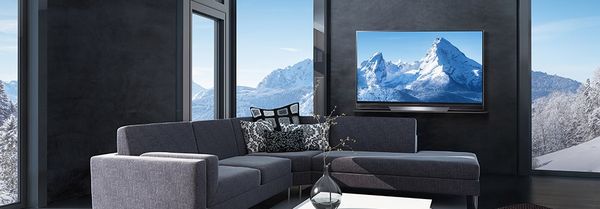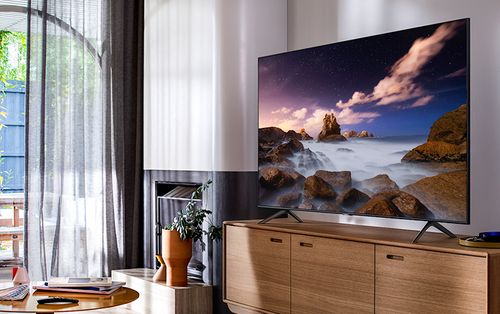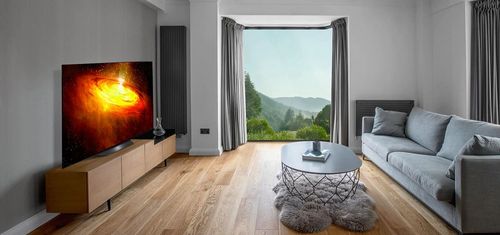
At A Glance:
The Basics: OLED Technology Explained
OLED Picture Quality: The Home Theater Game Changer?
OLED Expert Review: What Do the Pros Say?
Flat-screen televisions have evolved with dizzying speed, leaving homeowners to puzzle over a serious question: is OLED worth it? With price tags at the higher end of the spectrum and a growing chorus of tech reviewers hailing OLED as the gold standard in picture quality, it’s tempting to jump on board. But some experts warn that the best display tech isn’t always the right investment.
In this homeowners’ guide, we’ll walk through OLED technology explained in real-world terms, dig deep into OLED pros and cons, present balanced OLED expert reviews, and compare OLED vs QLED, OLED vs UHD, and OLED vs Mini-LED so you can decide if the buzz is justified, or if your money is better spent elsewhere. Consider this your no-nonsense roadmap to a smarter, sharper living-room upgrade.
Explore OLED TV's Offered at A&B TV
Enhance your home entertainment with the stylish options at A&B TV. Bring home the latest in television technology.
OLED TVsThe Basics: OLED Technology Explained

What is OLED, and Why Does It Matter?
OLED stands for “organic light-emitting diode” and it delivers a fundamentally different experience than traditional LED or LCD screens. Instead of relying on a single, powerful backlight behind a whole panel, each pixel in an OLED TV emits its own light or shuts off individually.
Imagine an art gallery where every painting has its personal spotlight, compared to a room lit overhead by a harsh fluorescent bulb. That’s the magic behind the OLED picture quality: total darkness next to brilliant highlights, richer color contrast, and sharper, more “cinematic” visuals.
Industry Terms, Demystified
- OLED vs UHD: UHD (Ultra High Definition) is a resolution standard (like 4K or 8K), not a panel technology. You can have a UHD OLED TV or a UHD LED TV.
- QLED: An LCD-based panel enhanced by a layer of quantum dots (offering higher brightness, often at a lower price).
- Mini-LED: An evolution of LED backlighting, using thousands of tiny LEDs for better control and contrast.
- Burn-in: A risk unique to OLED, where static images can create permanent “ghost” images on the screen.
OLED Picture Quality: The Home Theater Game Changer?

The Pros of OLED
Leading reviewers from CNET to Rtings and AVS Forum—tend to agree: nothing quite matches OLED picture quality for movies, streaming, and sports in a dim room. Here’s why homeowners and pros are impressed:
- Perfect black levels: Each pixel can turn off entirely, creating deep, inky blacks.
- Infinite contrast ratio: With true blacks and bright highlights, colors pop in a way LED/LCD panels can’t match.
- Ultra-wide viewing angles: Guests at the end of the couch see the same rich image as those front and center.
- Ultra-thin form factor: OLEDs can be made astonishingly thin, for a sleek, modern look.
The Cons of OLED
No technology is without trade-offs. Here’s the downside, straight from expert reviews and consumer reports:
- Price: OLEDs cost significantly more than most LED/LCD TVs, especially at large sizes.
- Burn-in risk: Static logos or HUDs (like news tickers or video game dashboards) can cause faint, lingering images over time.
- Lower peak brightness: Great in dark rooms, but less punchy in daylight-bright family rooms compared to QLEDs or Mini-LEDs.
- Fragility: OLED panels are a bit more delicate than their LED or Mini-LED rivals.
OLED vs QLED: The Showdown

QLED short for “quantum dot LED” is Samsung’s answer to OLED. Instead of lighting each pixel, QLED uses an ultra-bright backlight enhanced with quantum dots for vivid colors.
Advantages of QLED
- Higher brightness: Excellent for sunrooms or daytime viewing.
- Great for gaming: Lower risk of burn-in, ideal for screens with lots of static graphics.
- Generally lower cost: Comparable sizes can cost less than OLEDs.
Disadvantages Compared to OLED
- Local dimming limits: No matter how good, backlighting can’t create “perfect” blacks; there’s always some halo or bleed.
- Viewing angles: Picture quality fades faster off-center compared to OLED.
OLED vs Mini-LED: New Challenger in Town
Mini-LED is the latest evolution of LCD tech, pioneered by brands like TCL and LG. It leverages thousands of tiny LEDs for more granular control of brightness and contrast.
Advantages of Mini-LED
- Brighter than OLED: Great for bright rooms and HDR content.
- Lower risk of burn-in: Much less likely than with OLED panels.
- Competitive pricing: Often less expensive than OLED, especially at similar sizes.
Disadvantages Compared to OLED
- Black levels: Still can’t fully match the depth of OLED’s “perfect black.”
- Potential for blooming: Bright objects on dark backgrounds can cause halo effects (light bleeding into black areas).
When considering an OLED TV, it's easy to be swayed by the glossy pictures in showrooms, but take a step back: what actually matters for your home setup? OLED vs Mini-LED and OLED vs QLED face-offs highlight the importance of weighing all options especially since value isn't just about the latest buzzword or sticker price.
OLED vs UHD: Apples and Oranges
This comparison trips up many buyers. UHD is not a panel technology; it’s about how many pixels you get (think “4K” or “8K”). Most OLED TVs today are also UHD resolution, so buying an OLED doesn’t mean sacrificing sharpness.
OLED TV panels combine the wow factor of billions of colors and infinite contrast with ultra-high resolution for stunning, lifelike images. If you’re aiming for the best possible OLED picture quality and want those jaw-dropping details, a UHD resolution OLED TV is practically the Hollywood ticket to your own living room.
OLED Pros and Cons: Summing Up the Debate
Pros (When OLED is Worth It)
- Peerless picture quality, especially for movie lovers or those who value design.
- Best-in-class viewing from any seat in the room.
- Instant response time great for next-gen gaming.
Cons (Why Some Call OLED Overrated)
- High up-front cost.
- Picture quality advantages are less dramatic in bright rooms or casual viewing.
- Burn-in risk shouldn’t be ignored, especially for 24/7 news or static displays.
- For the same price, homeowners could go larger or brighter with QLED or Mini-LED.
So, for anyone still sitting on the fence, weighing up the OLED pros and cons can shine a light on whether an OLED panel is right for you, or if the practical perks of Mini-LED and QLED are a smarter investment.
OLED Expert Review: What Do the Pros Say?

- The Wall Street Journal lauds OLEDs for “the most striking, life-like movies and sports,” but warns about cost and handling.
- Consumer Reports places OLED at the top of performance rankings but notes “excel in home theaters or dim rooms, may be overkill in bright family spaces.”
- Digital Trends gives OLED best-in-class marks for cinephiles, but suggests considering QLED or Mini-LED for heavily sunlit rooms.
There’s no shortage of OLED expert reviews online and in tech magazines, but take a moment to read between the lines. Are these reviewers living in media caves or open-concept family rooms? Sometimes, only you know the true story of your household’s habits.
Is OLED Right for You?

- Room Environment: If your living room lets in a lot of daylight, QLED or Mini-LED might suit you better. OLED excels in home theaters or lower-light settings.
- Viewing Habits: Movie buff? Sports fanatic? OLED’s perfect blacks and true color may be worth the premium. Constant news or game HUDs? Consider the burn-in risk.
- Budget: Are you focused purely on the “best,” or do you want value for a larger screen or multi-room setup?
- Family Needs: Got kids? Less susceptible to fingerprints and more rugged, Mini-LED and QLED could be the safer, longer-lasting choice.
The Verdict: Is OLED Worth It or Overrated?
So, is OLED worth it? If pure performance, cinema-grade quality, and style are your top priorities, and your budget allows, OLED remains an unmatched choice for 2024 and beyond. For many homeowners, though, the practical perks of QLED and Mini-LED—a lower cost, brighter picture, and simpler care can outweigh OLED’s dazzling but sometimes overblown advantages.
Think of it like choosing a luxury car. It’s a thrill and head-turner, but sometimes a dependable crossover gets you, your family, and your investments further down the road.
Final Thoughts: Smart TV Upgrades for Smart Homeowners
Navigating the TV aisle—or pages of online reviews can be overwhelming. Whether you spring for an OLED TV, opt for a high-end QLED, or embrace the latest Mini-LED, matching your choice to your unique home environment and lifestyle is the smartest move.
Remember: It’s not about having the “best of the best” on paper, but about the best display, experience, and value for you and your family. Ask yourself: Is OLED worth it—for your space, habits, and budget? With a little strategic research, the right answer will stand out as clearly as an OLED pixel in a pitch-black night.
Ready to see the future of home entertainment? Know your options, set your standards, and upgrade with confidence with A&B TV, your local home entertainment experts. Contact us today!
Frequently Asked Questions
Electric blinds offer convenience, precise control, and can integrate into smart-home ecosystems. They’re great for hard-to-reach windows or busy homeowners but do come at a premium price. If ease-of-use matters and you enjoy tech, they’re worth considering.
Yes, especially in higher-end markets. Motorized blinds enhance perceived home value, improve energy efficiency, and appeal to tech-savvy buyers. Realtors report they are attractive bonus features during home sales.
Most modern OLED TVs are engineered to last 30,000–50,000 hours—enough for years of daily use. Burn-in is far less common with normal use, especially with newer panels and built-in pixel refresh features.
OLEDs offer instant response time and vibrant image quality, making them outstanding for console and PC gaming. Just use “care features” (like automatic dimming and pixel shifting) and don’t let static images linger to avoid burn-in.
Why Trust A&B TV?
With decades of experience in performance audio and video solutions, A&B TV has been a trusted name in the industry since 1967. As a family-owned and operated business, we take pride in offering competitive prices, expert guidance, and high-quality installations. Our 10,000 sq. ft. showroom features the largest selection of performance televisions in Central Texas, along with dedicated listening rooms where you can experience audio setups before making a decision. Backed by a knowledgeable team with over 300 years of combined experience, we ensure that every customer receives personalized service and expert advice. Visit DAVE and see why we’ve been Austin’s go-to A/V destination for over five decades!
Shop for OLED TV’s in Austin, TX
Experience the best in home entertainment by visiting A&B TV’s today! Whether you're looking for a simple upgrade or a full home theater setup, our expert team is here to guide you every step of the way. Stop by today to see and hear the difference for yourself! Can’t make it in? Visit our website to browse our online catalog, explore exclusive promotions, and learn more about our custom design and installation services.